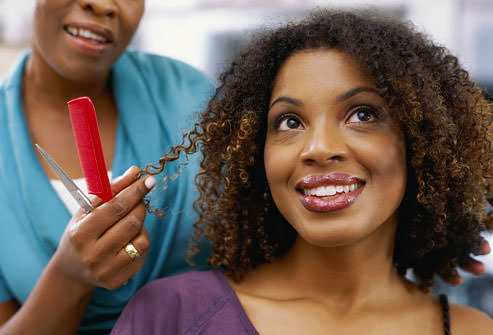
When a client sits in a professional’s chair for the first time an evaluation is done to determine the health of the client’s hair and scalp.
During this time most professionals will ask the clients questions about her hair’s condition and the products currently used.
In the old days, the professional would keep a card on each client so that he or she could effectively follow the client’s progress.
I have made a simple four step outline that will enable you to evaluate your hair at home. I will also provide a strategy that will enable you to begin treating your hair should you find that you are in need of additional treatment or support to bring your hair back to a healthy state.
Step 1:
Look closely at every area of the scalp. To do this, divide the hair in four sections. Make small partings across the section that you are working on and look closely at the scalp. Look for dry flaky areas, abrasions, lesions, pimples are redness.
Note the areas of concern, is there soreness or are there open sores? Make a note of where these areas are located as you proceed to repeat the same procedure for all four sections. This step will allow you to effectively evaluate your scalp’s health.
Areas of dandruff, soreness or irritation must be treated. It is important to begin a regimen that addresses scalp issues into your routine. Pre-poos, hot oil treatments, tea rinses and ACV treatments soothe and treat the scalp prior to shampooing.
Some may find that the treatments are more effective when done before and after shampooing. Avoid drying shampoos and choose shampoos that are formulated to moisturize or treat scalps. Please note that many shampoos formulated for scalp issues may be drying to the hair.
If this is the case, be mindful to apply the shampoo only on the scalp. To make application easier consider using an applicator bottle* and apply diluted shampoo. This is accomplished by adding 1 part shampoo, 1 part oil and 2 parts water. Shake the bottle and slowly squeeze the shampoo directly on the scalp while gently massaging.
Step 2:
Notice the density of each area. Are there areas that are thinner than others? If so, closely inspect these areas. Is the hair thicker at the root than it is at the ends of the hair?
If so this is a sign of damage, likely caused from weak areas (split ends). These areas need to be treated with a strengthening treatment, preferably one that has protein. To stop breakage immediately I suggest using either Aphogee* Two-Step Protein Treatment or Nexxus Polymedic Emergency Reconstructor.
I have used these products for years and they have proven to show immediate results. If you have an assortment of conditioners that you have already purchased, read the list of ingredients.
Ideal strengthening treatments will list protein among the first five ingredients. This will indicate that the conditioner has more protein than additional ingredients or fillers making it a better choice.
Ive done this but ive used my camera with flash on my hair n scalp….it helps me to keep notes day to day Of how hair/scalp health.
I recommend watching for changes in your hair to detect if there are any issues.
Step 2 questions regarding thinner areas and whether the hair is thicker at the root than at the ends are common and do not indicate that there is a problem except when there’s a change to where you notice that the density is less than what it used to be or your ends are much thinner than they usually are.
I say that because most people will have thin areas (whether they’re the sides, crown, edges…) and there’s rarely a person whose ends are as thick as their roots (just normal wear and tear and growth cycle of the hair will yield thinner ends than the roots).
A hair dresser who is not familiar with your hair can make bad judgement calls because they don’t know your hair or it’s history. Your hair may be improving, but in that moment in time, the hair dresser may only see the current status and not really be aware that it has made major progress. Communication is key there and simply knowing your hair will help you on the path to understanding what’s needed to remedy problems as they come about.
Thinning of the ends is an early indication of damage, whether it is from split ends or harsh manipulation. It is a good idea to begin or beef up conditioning if this is noted. I absolutely agree about communication, the sad thing is that many complain that their stylist do not ask many questions but instead “tell them what they need.” Ideally the hairdresser and the client continue to track the changes! Great comment Carla! Thank you for sharing!